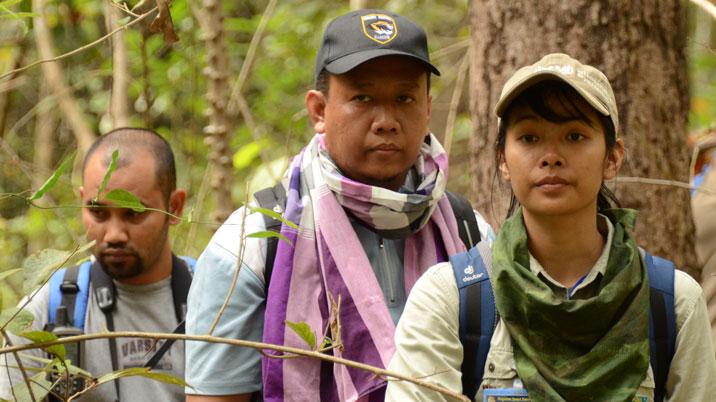BANGKOK, January 2012 — Somewhere near the border of Thailand and Myanmar, forest rangers from seven Southeast Asian countries were getting acquainted with Thai counterparts who patrol the Western Forest Complex at Huai Kha Khaeng Wildlife Sanctuary. Deep scratches on a tree were caused by a tiger’s swipe, a dead banteng lay below a trail in a river bed, and a tiger’s paw mark was imprinted on the marshy ground.
With each discovery, a ranger would input coordinates and observations into a hand-held GPS device while another documented the scenes with a digital camera. At the end of the patrol, the data were mapped using a grid system that pinpoints geographical areas where the threats to wildlife are greatest. The latest technology in smart systems help protected area managers and their ranger teams plan their next patrols and equips them for one of today’s most pressing conservation challenges: protecting the tiger in the wild from poaching and illegal trafficking.
“Rampant poaching and illegal wildlife trafficking pose the most immediate dangers to the survival of tigers in the wild. The professionals on the front lines in tiger range countries need to be equipped with the latest patrolling technologies and skills to partner with communities and confront this menace,” noted Keshav Varma, Program Director of the Global Tiger Initiative (GTI).
Training to beat wildlife crime
The patrol and mapping exercise was part of the hands-on training for wildlife conservation professionals from Cambodia, Indonesia, Lao PDR, Malaysia, Myanmar, Thailand, and Vietnam that took place in early January. The two-week workshop, “Regional Smart Patrol Training for Tiger Conservation,” was jointly organized by the World Bank Institute (WBI), the Government of Thailand – Department of National Parks, Wildlife and Plants Conservation, GTI, Smithsonian Conservation Biology Institute, and the Wildlife Conservation Society.
“The WBI’s Greater than Leadership Program is a year-long program designed to help accelerate implementation of modern patrolling techniques called ‘Smart Patrol’,” says Alison Wescott of the WBI. “What is unique about this leadership program is that it goes beyond training to provide a guided process and tools by which teams can reach their own goals,”
Country teams from protected areas—comprised of a conservation park manager, his deputy, lead ranger, and a local NGO partner- first agree on the precise nature of the problem they will tackle. This is followed by a brief but intensive leadership skills workshop at Huai Kha Khaeng Wildlife Sanctuary that has been successfully implementing the Smart Patrol system known as MIST for more than five years. They then go back to their own conservation areas and apply their new skills in an 11-month results laboratory phase. The Smithsonian Conservation Biology Institute will provide ongoing technical advice to the teams and a set of expert networks, with additional advice on leadership and change from the WBI that could include field-based coaching.
Leadership and conservation work
Ms. Wescott, a member of the faculty team, says: “It was very exciting to work with the protected area management teams from seven tiger range countries. These teams are on the front lines of law enforcement, fighting the battle against poaching and illegal trafficking and trade. Leadership is important. It is about mobilizing people and groups, with the right stuff, who have the authority and ability to take action. Our objective was to help these conservation teams be more successful in introducing Smart Patrol when they go back to their countries and be more able to implement it.”
According to Tony Lambino, another WBI faculty member, “Experts have repeatedly stressed that tiger protection requires close collaboration among key stakeholders. So we worked with participants on applying stakeholder analysis, strategic communication, and rapid results so that, moving forward, they can make informed decisions on who they need to work with, who else they need to persuade, and who they’re up against and, most importantly, how to build a coalition in support of tiger conservation.”
GTI hopes that this new approach will help it meet its strategic goal of doubling the number of tigers in the wild by the next Year of the Tiger, 2022. Globally, there are only about 3,200 tigers left in the wild and only about 250 in Thailand.


